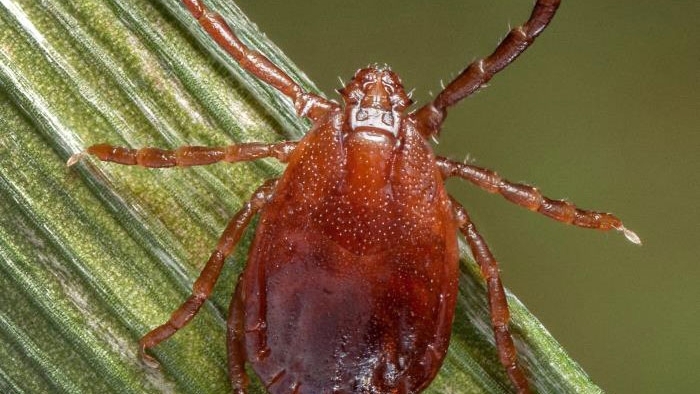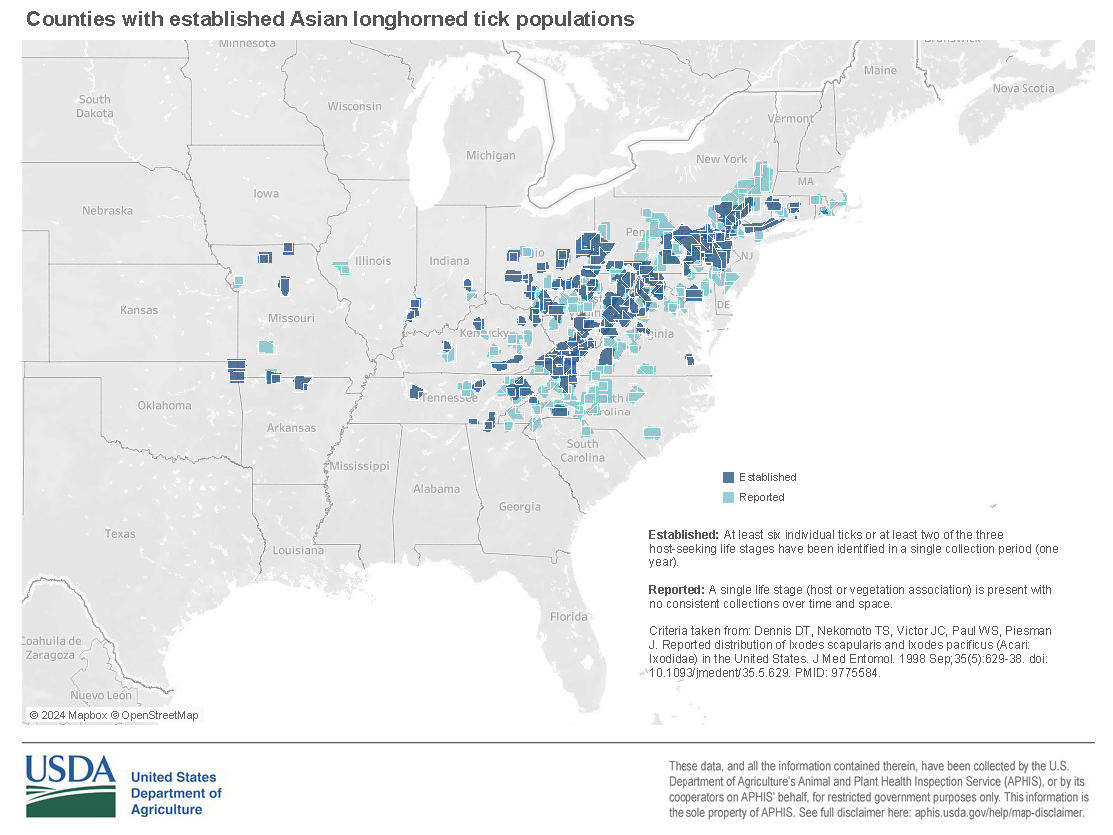Asian Longhorned Ticks

Adult female Asian longhorned tick on a plant stem (James Gathany, CDC)
Asian longhorned ticks (Haemaphysalis longicornis) are invasive pests that pose a serious threat to livestock in the United States. They can form large infestations on one animal and spread diseases that impact both animals and people.
In November 2017, public health officials in Hunterdon County, NJ, reported the first detection of the Asian longhorned tick outside of a U.S. port of entry inspection site. It then spread to numerous Eastern States. Asian longhorned ticks aren't normally found in the Western Hemisphere.
APHIS provides updates to State agencies to inform planning, surveillance, outreach, control, and overall collaboration on the Asian longhorned tick.
Asian longhorned tick populations in the United States are parthenogenetic, meaning an individual female can lay eggs without mating, essentially cloning herself to create the next generation. This is one reason the Asian longhorned tick is a successful invader of new geographic regions.
- Unfed Asian longhorned ticks are light reddish-tan to dark reddish with brown, dark markings.
- Adult females are grey-green with yellowish markings and the size of a pea after feeding. Male ticks are rare.
- Other unfed stages of the tick are very small, about the size of a sesame seed, or even smaller.
For more details, view our pest alert (1004.99 KB) and story map about Asian longhorned ticks.
Various strategies effectively mitigate tick populations on hosts and in the environment.
Livestock
- Regular tick treatments should be effective against Asian longhorned ticks. Consult your veterinarian or agriculture extension agent about which products to use.
- Check your livestock for ticks regularly.
- Safely remove ticks from people and pets as quickly as possible. If you think you've found an Asian longhorned tick, seal it in a zip-top bag and give it to your veterinarian for identification.
Environment
- Habitat modifications can help prevent ticks on feedlots and pastures. This may include mowing grass, removing trees, reducing shade by thinning trees, understory removal, and placing mulch barriers.
- Apply acaricide using label instructions to tick habitats, such as woodland edges and grassy patches, during times when ticks are most actively seeking hosts. Although it varies by year, Asian longhorned ticks are generally active from March to November. Consult your State and local regulations for approved acaricides.
Report Signs of Animal Disease
Producers or owners who suspect an animal disease should contact their veterinarian to evaluate the animal or herd. Find an accredited veterinarian.
Animal health professionals (veterinarians; diagnostic laboratories; public health, zoo, or wildlife personnel; and others) report diagnosed or suspected cases of nationally listed reportable animal diseases to APHIS Area Veterinarians in Charge and to the State animal health official as applicable under State reporting regulations.
Controlling Asian Longhorned Ticks
The (Asian) longhorned tick is also called the bush, cattle, or scrub tick, depending on geographic region. The native range of this tick species includes eastern China, Japan, the Russian Far East, and Korea. It has spread to Australia, New Zealand, and several island nations in the western Pacific Region.
In the United States, longhorned ticks have been collected in many areas in the Eastern half of the country from New York south to Georgia and west to Missouri.

Asian longhorned ticks in the United States successfully transmitted Theileria orientalis Ikeda to cattle in the laboratory. This pathogen has also been detected in field-collected Asian longhorned ticks by PCR (polymerase chain reaction).
These ticks are not competent vectors of Borrelia burgdorferi (Lyme disease) or Anaplasma phagocytophilum (human granulocytic anaplasmosis).
View our emerging risk notice on Theileria orientalis Ikeda (188.06 KB) (2021) or our Cattle Theileriosis fact sheet (296.21 KB) for more details.

